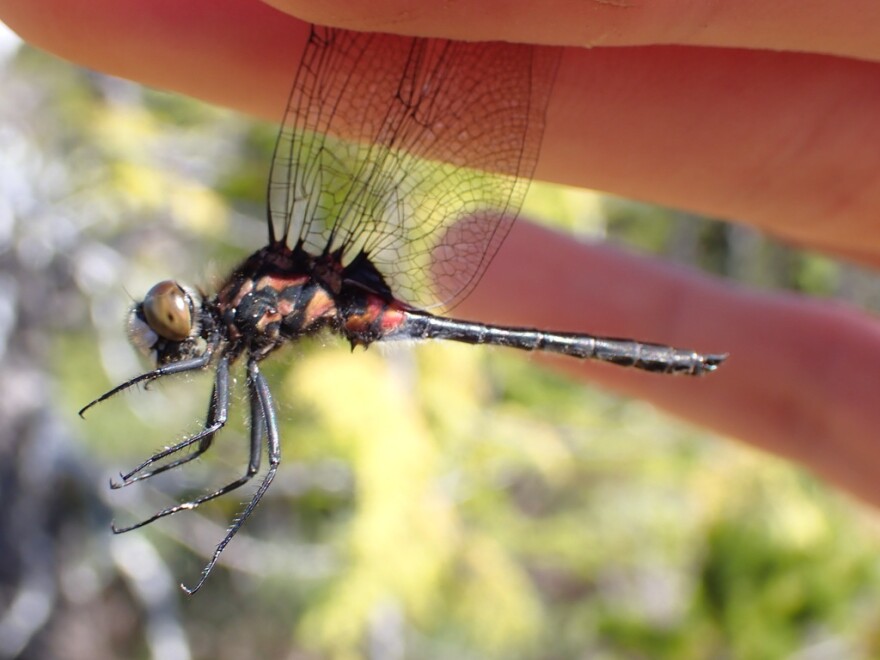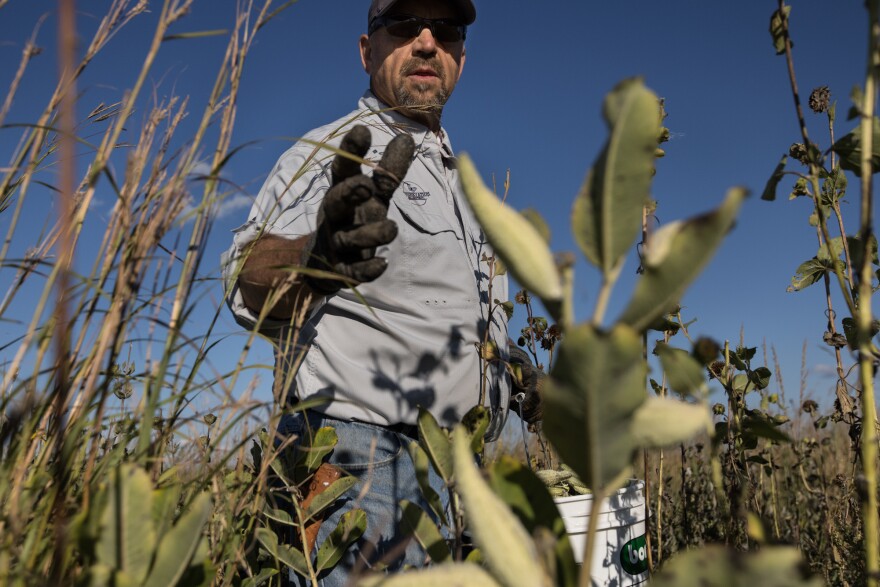John Latimer found his first few gray tree froglets last week!
These tiny frogs are just three-quarters of an inch when they emerge from the ponds. John expects to see many baby frogs and toads emerging over the next few weeks. (I’ve been finding veritable swarms of baby leopard frogs near Stillwater.)
Gray tree frogs are able to change color from a bright, lime green to a light, clean gray. They have sticky little toe pads allowing them to hang on to leaves and bark, and they are often found hidden in little niches or crevices during the daytime.
Safely handling dragonflies and butterflies
With the advice of Professional Bug Apprehenders (entomologists), John has learned the best way to hold dragonflies and butterflies is the “scissors” hold between two fingers. This is much better than holding them between your finger and thumb, because you’re less likely to accidentally crinkle the wings (in the case of a dragonfly) or rub off the scales (butterfly) by accident.

When you have these incredible insects in hand, you can see more details, allowing you to identify them and determine their relative age. John caught a monarch butterfly last week whose wings were the vibrant, unblemished and untorn black-and-gold of a freshly emerged adult. Older individuals will show some of the wear and tear of life, with drab patches on their wings where the scales have rubbed off and more tearing and damage to the wing margins.
Adult monarch butterflies alive right now do not migrate during their lifespan. Instead, their offspring will be the “super” generation of monarchs. The eggs the current generation lays will hatch and the eventual butterflies will migrate all the way south to Mexico. They will overwinter there and fly to the southern U.S. to lay their eggs in the spring. The subsequent generation continues the migration north from there.
The “super” generation (the one that migrates the farthest and overwinters in Mexico) lives 8-9 months. The other three generations live just 2-6 weeks!
Please note as schools let out for the summer, we become more and more hungry for reports for our Phenology Talkbacks segment. Please don’t hesitate to reach out with your observations, nature tales and insights! Get in touch with me (smitchell@kaxe.org), John Latimer (jlatimer@kaxe.org), or text "phenology" to 218-326-1234.
Feed me, mother

John’s birdfeeders are beset by befuddled baby birds and overworked Rose-breasted Grosbeak, Red-winged Blackbird and Purple Finch parents. The forlorn little fledglings haven’t quite figured out how to eat by themselves. They will perch on the birdfeeder within easy reach of a week’s supply of food and still think they’re starving!
They will flutter their wings and beg impatiently for their parents to come over, grab the food and shove it into their mouths. Eventually, the baby birds will begin to hesitantly peck at the seeds and become more independent, but it’s a funny sight (for us) at the moment.
The young birds are also still learning to fly properly. For a short time after leaving the nest, it’s common for young birds to be “grounded” as they learn to fly. John’s rule of thumb for determining if a baby bird needs help is this: if the bird is able to try to escape from him, it doesn’t need help. If the baby bird just sits there helplessly as he approaches, and he doesn’t have to chase it, it does need help.
If you find a baby bird in need of help, look up to see if you can locate its nest. If you’re able to find it, just place the bird back in the nest. Don’t fear that the mother will reject it because it smells like you, that’s a myth! Most songbirds have terrible senses of smell, and parents will readily accept their replaced offspring.
Young birds also have a hard time avoiding windows. If possible, equip windows near birdfeeders with birdsavers or use other collision-prevention tactics.
Dynamic dragonflies
John has “spotted” 12-spotted skimmers, widow skimmers, common whitetails and a few darners over the past week. Meadowhawks are beginning to emerge (other than the early meadowhawk and variegated meadowhawk, which emerge early in the season). Autumn meadowhawks, saffron-winged meadowhawks, white-faced meadowhawks, and more will be out soon!
Meadowhawks tend to be small dragonflies compared to their early-season comrades. They rarely grow to be more than an inch-and-a-half long. Males are generally bright red, while females are in shades of gold or brown.
Jewelwing damselflies have disappeared for the season. The largest damselflies found in Northern Minnesota are the ebony jewelwing and the river jewelwing. Ebony jewelwings have jet-black wings, while river jewelwings have black-tipped wings with amber-colored patches.
(Reminder: damselflies are thinner-bodied than dragonflies and rest with their wings held over their backs. They have hammerhead-shaped faces and look much more fragile than a dragonfly.)
John found his first few grey tree froglets last week! These tiny frogs are just three-quarters of an inch when they emerge from the ponds. John expects to see many baby frogs and toads emerging over the next few weeks. (I’ve been finding veritable swarms of baby leopard frogs near Stillwater, MN.)
Grey tree frogs are able to change color from a bright, lime green to a light, clean grey. They have sticky little toe pads that allow them to hang on to leaves and bark, and are often found hidden in little niches or crevices during the daytime.
Sowing milkweeds

John is beginning to find seed pods on common milkweed plants. They are about an inch long and bright green right now but will get much larger and turn brown as they mature.
The development of milkweed flowers into seeds is quite interesting. As they flower, you’ll see 30-50 flowers in a cluster, which will produce 3-4 seed pods. Luckily, not all these flowers must be pollinated to produce seeds.
Pollination is an involved process, and the milkweed has developed specialized tactics to increase the likelihood of its pollen moving from plant to plant. The pollen grains are held on the end of a bobby-pin shaped structure. When an insect lands on the flower, its legs slip into the “bobby pin” and get stuck. As a result, when the insect leaves again it brings with it a tiny pollen hitchhiker. With luck, the insect will then visit another milkweed plant and deposit the pollen where it’s needed.
If you’d like to see more milkweeds, you can take the mature seed pods and help them take root in a new area. If you rake up the soil, break open the pod, and distribute the seeds in the raked-up area, you’ll be well on your way to a new patch of milkweeds!
Bats
John was thrilled to see a bat outside his window!
These have been hard to find recently as white-nose syndrome has decimated populations of communally hibernating bats. This fatal illness is caused by a fungus, which is passed between bats as they hibernate closely together. The fungus causes their bodies to drop fat rapidly, often causing starvation before winter’s end.
John is hoping to get a bat expert on-air so we can learn more! If you are a bat expert (or know one), send me an email at smitchell@kaxe.org.
Plant progression
- Ripe fruit: Ripe edible fruit includes pin cherries and bunchberries. Inedible ripe fruit includes red elderberries.
- Not yet ripe fruit/seeds: Common milkweed, chokecherries, black chokeberry, bluebead lily.
- Peak flowering: Fireweed, wild rice.
Plant spotlight

Fireweed is a beautiful plant that grows in roadside ditches. Before settlement, these flowers preferred areas that had recently been burned. Now, due to fire suppression, they prefer the disturbed soil along roadsides. They are a gorgeous magenta color and will brighten up your drive.
That does it for this week! For more phenology, subscribe to our Season Watch Newsletter or visit the Season Watch Facebook page.
Funding for this project was provided by the Minnesota Environment and Natural Resources Trust Fund as recommended by the Legislative-Citizen Commission on Minnesota Resources (LCCMR).








